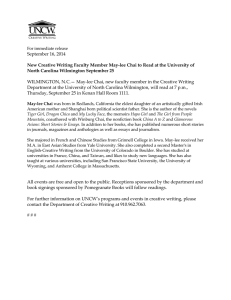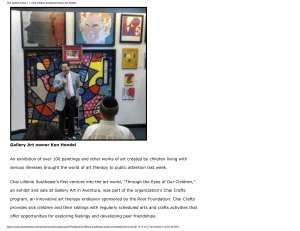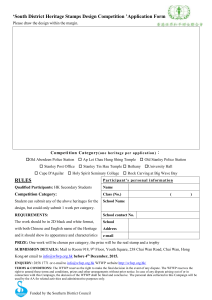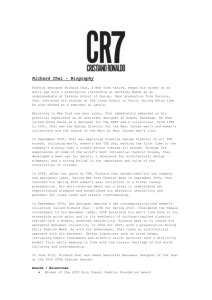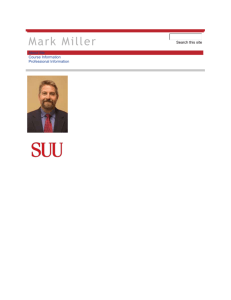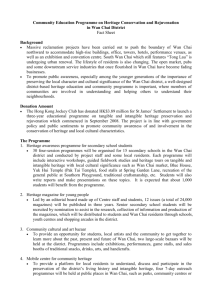Q&A on Pediatric HIV/AIDS Treatment
advertisement
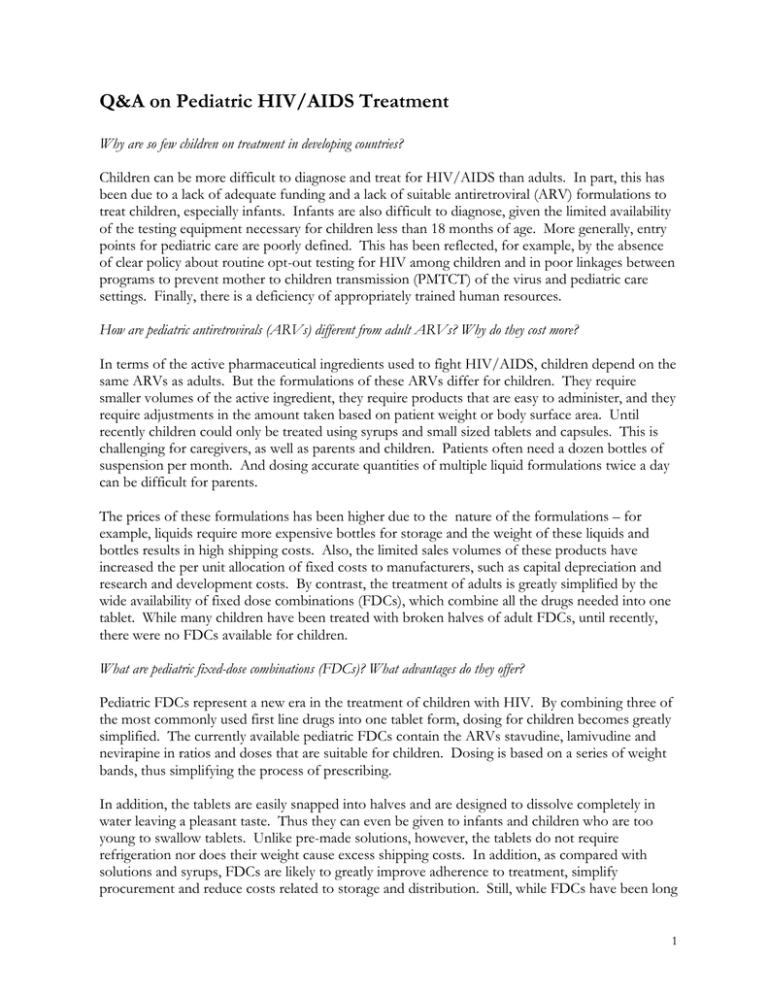
Q&A on Pediatric HIV/AIDS Treatment Why are so few children on treatment in developing countries? Children can be more difficult to diagnose and treat for HIV/AIDS than adults. In part, this has been due to a lack of adequate funding and a lack of suitable antiretroviral (ARV) formulations to treat children, especially infants. Infants are also difficult to diagnose, given the limited availability of the testing equipment necessary for children less than 18 months of age. More generally, entry points for pediatric care are poorly defined. This has been reflected, for example, by the absence of clear policy about routine opt-out testing for HIV among children and in poor linkages between programs to prevent mother to children transmission (PMTCT) of the virus and pediatric care settings. Finally, there is a deficiency of appropriately trained human resources. How are pediatric antiretrovirals (ARVs) different from adult ARVs? Why do they cost more? In terms of the active pharmaceutical ingredients used to fight HIV/AIDS, children depend on the same ARVs as adults. But the formulations of these ARVs differ for children. They require smaller volumes of the active ingredient, they require products that are easy to administer, and they require adjustments in the amount taken based on patient weight or body surface area. Until recently children could only be treated using syrups and small sized tablets and capsules. This is challenging for caregivers, as well as parents and children. Patients often need a dozen bottles of suspension per month. And dosing accurate quantities of multiple liquid formulations twice a day can be difficult for parents. The prices of these formulations has been higher due to the nature of the formulations – for example, liquids require more expensive bottles for storage and the weight of these liquids and bottles results in high shipping costs. Also, the limited sales volumes of these products have increased the per unit allocation of fixed costs to manufacturers, such as capital depreciation and research and development costs. By contrast, the treatment of adults is greatly simplified by the wide availability of fixed dose combinations (FDCs), which combine all the drugs needed into one tablet. While many children have been treated with broken halves of adult FDCs, until recently, there were no FDCs available for children. What are pediatric fixed-dose combinations (FDCs)? What advantages do they offer? Pediatric FDCs represent a new era in the treatment of children with HIV. By combining three of the most commonly used first line drugs into one tablet form, dosing for children becomes greatly simplified. The currently available pediatric FDCs contain the ARVs stavudine, lamivudine and nevirapine in ratios and doses that are suitable for children. Dosing is based on a series of weight bands, thus simplifying the process of prescribing. In addition, the tablets are easily snapped into halves and are designed to dissolve completely in water leaving a pleasant taste. Thus they can even be given to infants and children who are too young to swallow tablets. Unlike pre-made solutions, however, the tablets do not require refrigeration nor does their weight cause excess shipping costs. In addition, as compared with solutions and syrups, FDCs are likely to greatly improve adherence to treatment, simplify procurement and reduce costs related to storage and distribution. Still, while FDCs have been long 1 awaited, the current breakthrough represents only a beginning. CHAI, in partnership with the World Health Organization (WHO), UNICEF and others, will continue to work with manufacturers to ensure an expanded range of pediatric FDCs containing different drug combinations in order to offer better choices to providers and patients alike. Are peds FDCs already being used in developing countries? What is their track record? Pediatric FDCs are relatively new to the market. Currently, they are used widely only in India, where they have helped accelerate the pace of treatment scale-up – with some states increasing the number of children on treatment by more than 20% in three months. Several other countries including Mozambique and the Democratic Republic of the Congo have recently registered pediatric FDCs and are preparing to administer them through their national care programs. The pediatric FDCs have been shown to demonstrate “bio-equivalence” in healthy volunteer trials where dosing using pediatric FDCs was compared with measured syrup doses. A trial which is soon to be completed in Zambia has compared doses and responses in children treated with pediatric FDCs versus syrups. The most compelling evidence of the value of FDCs for children was reflected in a large Médecins Sans Frontières study which used halved adult FDCs. Doesn’t it take more than drugs to treat children? What is CHAI doing other than lowering prices? Yes – the availability and affordability of pediatric drugs is only part of the solution. A critical constraint is the lack of overall infrastructure to adequately identify and treat children in the health care system. CHAI and its government partners are actively working to improve health care infrastructure, train doctors and health care workers, create and or improve infant diagnosis infrastructure, update treatment guidelines and improve entry points for diagnosing children. CHAI has raised $15 million for this work to accompany the $35 million from UNITAID which will be used to supply the drugs and diagnostics. What else will CHAI buy with UNITAID money for pediatric HIV/AIDS treatment? CHAI will also use UNITAID funds to supply laboratory instruments and tests for HIV/AIDS diagnosis and monitoring, including rapid tests, CD4 tests and, for infant diagnosis, DNA PCR and RNA PCR. CHAI will also supply the antibiotic cotrimoxazole and ready-to-use therapeutic food (RUTF). Studies show that the preventative daily use of half a tablet of cotrimoxazole can reduce HIV-related mortality in young children by more than a third. RUTF is used to treat severe and acute malnutrition; it also helps to improve the response to treatment and to reduce toxicities associated with ARV use. Is procurement by CHAI going to create a bias in what products/regimens countries are using? No – CHAI is going to procure products under UNITAID in consultation with and ultimately in deference to the national governments of each beneficiary country. CHAI will advise national governments on the price, suitability and quality specifications of available pediatric formulations. CHAI will also help governments quantify required volumes of products and help ensure that the products the government wishes to procure are consistent with international clinical guidelines and quality assurance standards. However, the final decision regarding products to be procured will be taken by the national government of each beneficiary country, on whose behalf CHAI will act as a procurement agent for ARVs being financed by UNITAID. 2 Will CHAI be running the treatment programs? If not, how can it ensure success? No – CHAI works in partnership with national governments to support the scale-up of public treatment programs. Rather than operate separate clinics or programs, CHAI invests in strengthening the capacity of the Ministry of Health to provide high quality care and treatment to as many people as possible. This approach aims to make pediatric HIV/AIDS treatment widely available while strengthening overall health systems and ensuring long-term sustainability. How are you helping HIV-positive children who don’t need treatment yet? What about the parents of HIV-positive children? Will they get treatment too? CHAI’s goal is to improve the quality of life of all children living with HIV/AIDS through comprehensive care for those not yet ready for treatment and with ARV therapy for those who need it. In addition to ARVs, CHAI and UNITAID will provide cotrimoxazole, RUTF and CD4 testing which can be used to care for HIV-positive children not yet on treatment. Cotrimoxazole is used to prevent and treat bacterial infections which are common among HIV-positive children. RUTF is used to treat severe and acute malnutrition, another common cause of morbidity and mortality among HIV-positive children. CD4 testing is used to monitor patients’ immune function and guide decision-making on initiation of ARVs. These commodities can help keep children healthy even before they need to start using ARVs. Because the majority of pediatric HIV infections are transmitted from mother to child, CHAI encourages a family-centered approach to identifying and treating children with HIV/AIDS. This approach integrates care for the child, parents and other members of the family in one facility. Pediatric treatment programs cannot operate in isolation from the needs of the rest of the family, which is essential to supporting the overall wellbeing and health of the child. What are others (e.g., Global Fund, WHO, UNICEF) doing to treat children? Increased access to pediatric treatment will depend on the actions of many partners. The Global Fund is already providing some money to fund pediatric treatment, and it will be a critical source of large-scale funding to make it possible to treat hundreds of thousands of children in the future and on an ongoing basis. Both the Global Fund and the U.S. President’s Emergency Plan for AIDS Relief (PEPFAR) have helped fund the adult treatment programs and related procurement systems that are serving as the foundation for more pediatric care. PEPFAR is also substantially increasing the availability of funding for pediatric treatment, and CHAI and PEPFAR will collaborate to maximize the benefit of the new funding available from UNITAID and PEPFAR. PEPFAR is also working alongside the WHO to ensure appropriate guidelines and clinical protocols for pediatric treatment. Both are also engaging governments, nongovernmental partners and manufacturers to plan for the most effective possible dosing of existing FDCs and to prioritize the development of new FDCs. The WHO provides a wide range of technical support directly to governments, as does UNICEF and other United Nations agencies. UNICEF’s programs on the ground, which provide comprehensive healthcare services for children ranging from vaccination to education, are a necessary complement to services specifically oriented at HIV/AIDS treatment. These are all important partners to CHAI and to the governments CHAI and UNITAID are supporting to expand pediatric treatment in 2007. 3 Q&A on New Pediatric Antiretroviral Pricing Agreements How do CHAI’s new prices compare to current prices in the market? The non-governmental organization Médecins Sans Frontières (MSF) publishes a report of list prices from ARV suppliers (www.accessmed-msf.org/documents/untanglingtheweb%209.pdf). According to the prices in this report, the prices being offered for the 19 pediatric formulations covered under CHAI’s new pricing agreements are, on average, 45 percent less than the lowest rates offered currently to low-income countries. The WHO reports actual prices paid for ARVs in a Global Price Reporting Mechanism (GPRM) database (www.who.int/3by5/amds/price). According to this reference, the prices being offered for the 19 pediatric formulations covered in CHAI’s new agreements are, on average, more than 60 percent lower than prices in low-income countries and more than 70 percent lower the prices in lower and upper middle-income countries. The table below provides additional detail, including a price comparison for each formulation. Name and strength CHAI Price MSF List Price1 Per pill/ml Per pill/ml Reduction GPRM Low Income2 Per pill/ml Reduction GPRM Middle Income2 Per pill/ml Reduction ABC (20mg/ml) $ 0.073 $ 0.104 30% $ 0.136 46% $ 0.172 58% ddI (2g or 10mg/ml) $ 0.020 $ 0.065 69% $ 0.116 83% $ 0.336 94% ddI (25mg) $ 0.019 $ 0.117 83% $ 0.121 84% $ 0.165 88% ddI (50mg) $ 0.036 $ 0.158 77% $ 0.163 78% $ 0.171 79% ddI (100mg) $ 0.130 $ 0.213 39% $ 0.214 39% $ 0.424 69% ddI (150mg) $ 0.195 $ 0.308 37% $ 0.361 46% $ 0.374 48% ddI (200mg) $ 0.260 $ 0.425 39% $ 0.427 39% $ 0.481 46% EFV (50mg) $ 0.083 $ 0.116 28% $ 0.142 42% $ 0.123 33% Product 3TC (20mg) + d4T (5mg) + NVP (35mg) * * * N/A N/A N/A N/A 3TC (40mg) + d4T (10mg) + NVP (70mg) * * * N/A N/A N/A N/A 3TC (30mg) + d4T (6mg) + NVP (50mg) $ 0.037 $ 0.108 65% $ 0.140 73% N/A N/A 3TC (60mg) + d4T (12mg) + NVP (100mg) $ 0.075 $ 0.125 40% $ 0.140 47% N/A N/A 3TC (50mg/5ml) $ 0.008 $ 0.018 58% $ 0.023 68% $ 0.064 88% NVP (50mg/5ml) $ 0.008 $ 0.025 68% $ 0.052 84% $ 0.084 90% d4T (1mg/ml) $ 0.007 $ 0.008 10% $ 0.021 68% $ 0.088 92% d4T (15mg) $ 0.025 $ 0.082 70% $ 0.083 70% $ 0.657 96% d4T (20mg) $ 0.030 $ 0.056 46% $ 0.088 66% $ 0.121 75% AZT (50mg/5ml) $ 0.009 $ 0.014 36% $ 0.030 70% $ 0.066 87% AZT (100mg) $ 0.055 $ 0.075 27% $ 0.104 47% $ 0.127 57% Average reduction in price 45% 0 62% 0 73% Notes: (1) Prices based on the 9th edition (revised) of MSF's "Untangling the Web." For each product, the price refers to the lowest price supplier that is WHO prequalified or FDA approved, unless no supplier has WHO/FDA approval yet. In these cases, the supplier has made a submission to WHO and/or FDA and is eligible to supply according to the quality assurance policies of the Global Fund. (2) Prices as reported to the WHO's Global Price Reporting Mechanism database (available online at www.who.int/hiv/amds/price/hdd/), as accessed on November 28, 2006. N/A means no data were available. Prices are from orders since July 1, 2005. Income classifications of countries are based on World Bank definitions (*) For the purposes of the announcement of its new agreements with CHAI, Ranbaxy has requested that the prices of products it is exclusively supplying not be specified in documents being widely circulated to the public. That average price reduction figure, however, does incorporate this information. CHAI will inform eligible countries of the prices and associated terms & considtions for these products. 4 Are there any hidden or additional costs that purchasers will need to pay? In general, CHAI prices are ceiling rates at or below which CHAI suppliers quote in response to tenders. Because the quote may fall below the ceiling, the cumulative impact of any additional charges can be marginal. For example, in the last three years more than 500 million pills have been sold under CHAI agreements; including all shipping charges, the final price paid for these products has been, on average, only two percent more than the original ceilings set by the agreements. The ceiling prices themselves are in “Free on Board” (FOB) terms, meaning that they do not include applicable shipping and handling charges from the point of export. It is common for the prices of ARVs to be reported as FOB. Shipping and handling fees add to the FOB price of a product. In addition, some purchasers choose to use procurement agents such as UNICEF, IDA or Crown Agents, which typically adds 5-10% to the price. These costs are not particular to products and prices offered under CHAI agreements. Will CHAI be procuring these new products? Yes – CHAI will be procuring these pediatric formulations (and some adult formulations, as well) for the 40 countries which have been confirmed as beneficiaries of UNITAID financing. For these countries, CHAI will serve as the procurement agent or as the party responsible for payment when local procurement systems are used. For procurement outside of UNITAID-funded purchases, national governments maintain autonomy over the procurement process, and CHAI agreements support these practices. For the supply of some pediatric formulations, even outside of UNITAID-funded purchases, CHAI must act as the procurement or sourcing agent for members of its Procurement Consortium to access prices agreed with particular suppliers. Who else has access to Clinton Foundation products and prices, and what is required of them? Prices and products included in CHAI agreements are available to countries participating in the CHAI Procurement Consortium, which currently includes 62 nations. These prices apply to procurements using funding from local governments, the Global Fund and/or UNITAID which are conducted to support public care and treatment programs. Products should be purchased directly from partner suppliers or through agents representing the aforementioned programs and funding sources. Prices and products included in the new pediatric agreements can be supplied directly by Cipla and Ranbaxy to countries that are members of the Procurement Consortium but not UNITAID beneficiaries. Some pediatric formulations from suppliers other than Cipla and Ranbaxy (as indicated in CHAI’s “ARV Price List”) are available to such countries on the basis of CHAI acting as the procurement or sourcing agent. Access to CHAI prices assumes prompt payment following the shipment of orders. In addition, Procurement Consortium members commit to principles of sound procurement, typically reflected in a memorandum of understanding (MOU) with CHAI. These include aggregated national orders; reliance on international quality standards like prequalification by the WHO or U.S. FDA approval; expedited national registration based on those standards; secure distribution of product in country (to avoid leakage into high-income markets); compliance with national and international law protecting intellectual property; and movement towards using multi-year tenders and splitting high-volume orders across multiple suppliers. 5 Will the new prices be available to PEPFAR? No – The use of U.S. government funding under PEPFAR to procure ARVs requires that the ARVs being purchased comply with the specifications and standards of U.S. FDA regulatory approval (or tentative approval). These specifications and standards have implications to the manufacturing cost of suppliers, for example due to requirements related to the packing material, labeling specifications and package inserts. These additional costs are not reflected in prices negotiated with CHAI, and therefore suppliers who wish to supply these same pediatric formulations to purchasers using U.S. government money under PEPFAR will need to separately negotiate the prices for such procurement. Why is CHAI working with these particular companies? CHAI welcomes the opportunity to partner with other manufacturers, including originators, for pediatric formulations and other products. Pricing under CHAI agreements requires suppliers to treat the market of developing countries as a low-margin, high-volume business. CHAI partner suppliers agree to take a “cost-plus” approach, whereby they agree to specified margins and markups that cover all costs, including depreciation of capital. Cipla and Ranbaxy have agreed to this approach for pediatric formulations, making the prices announced today possible. Other CHAI partners, including Aspen, Hetero and Strides, do not supply these products but remain strong partners to CHAI in the supply of adult ARV formulations, consistent with prior agreements. However, CHAI will not be limiting the supply of pediatric formulations only to Cipla and Ranbaxy. CHAI also expects to purchase ARVs from Abbott, Aurobindo, Bristol Myers Squibb, Merck, Roche and others, based on responses to its invitation and the product requirements of UNITAID beneficiaries. In response to an open invitation issued to 14 manufacturers, CHAI has concluded agreements which lower the prices of 19 pediatric formulations. Is CHAI stifling competition by not working with others? No – CHAI agreements do not require purchasers to buy from CHAI suppliers. Countries are encouraged to retain normal procurement practices, including open tenders. Even for the products and volumes for which CHAI will be procuring, it is ensuring multiple sources of supply for each product. Because the prices set by CHAI agreements reflect production costs and margin, other manufacturers can also compete at these levels if they choose to lower their prices. In 2003, CHAI announced pricing agreements for first-line ARVs with five companies. Since that time, more manufacturers have entered the market, and average market rates have fallen to be within range of those set by CHAI partners. CHAI expects the same pattern to follow its agreements for pediatric formulations. Are these nonprofit prices? How are they sustainable? No – Prices negotiated under CHAI agreements cover production costs to suppliers, including depreciation and cost of capital, as well as margin. Suppliers who agree to these prices treat this market as a low-margin, high-volume business, recognizing AIDS as a global health emergency. However, the supply of these products can only be sustainable if the manufacturers make a sufficient return on these and other products to enable ongoing research and development, 6 production and growth. CHAI therefore does not seek or encourage nonprofit or less-than-cost prices, as the short-term benefits of such an approach can undermine long-term sustainability. For HIV/AIDS, long-term sustainability of supply is critical given that treatment is a life-long commitment for patients. What if a supplier is not registered in a country that needs a drug, or cannot meet demand for an order? CHAI has negotiated agreements with at least two suppliers for 12 of the 19 pediatric formulations for which prices were announced today. For these 12 products, if a country cannot procure from a particular supplier due to the reasons mentioned above, the country has the option of using an alternative supplier for that product, while continuing to access the ceiling price negotiated for that formulation. For the four peds FDC formulations and three formulations of didanosine, only one manufacturer exists per formulation that is eligible to supply at the ceiling price specified by CHAI according to the quality assurance criteria for UNITAID procurement. For the peds FDCs, Cipla and Ranbaxy’s products themselves are alternatives to one another. For the three formulations of didanosine, an alternative source of supply is the originator, Bristol Myers Squibb; however, in these three cases, pricing from this alternative source of supply may not be consistent with CHAI’s negotiated ceiling prices. Have these products received WHO and/or FDA approval yet? Twelve of the 19 formulations included in the agreements being announced today have been approved by the WHO and/or FDA for one or more supplier(s). The remaining products have been submitted for review. These submissions include data from bioequivalence testing conducted by research laboratories that have been successfully audited by the WHO and/or FDA. CHAI will only be purchasing ARVs that are eligible according to the quality assurance standards of the Global Fund, standards that UNITAID has also adopted. 7 Q&A on UNITAID and its Partnership with CHAI What is UNITAID? UNITAID is a newly formed global health initiative that seeks to provide sustained financing to support the provision of drugs and diagnostics for the treatment and care of HIV/AIDS, malaria and tuberculosis to affected people in developing countries. Its aim is to support and complement the role of existing international institutions by addressing specific segments or “gaps” in the current international public health architecture for the three disease areas. The initiative plans to implement targeted programs with the intention of catalyzing changes in the marketplace for key commodities in the three disease areas and to improve access to those commodities by patients in need in the poorest countries in the world. How is UNITAID funded? Who are its major donors? Funding to UNITAID is provided by commitments from a set of governments that have adopted innovative and sustained financing mechanisms. France led the creation of UNITAID with the adoption of a levy on airline tickets that was passed by the French Parliament and went into effect on July 1, 2006 and is expected to raise approximately €200 million in 2007. Brazil, Chile, Norway and the United Kingdom are the other founding donors that have pledged commitments to UNITAID using funds generated from taxes on airline tickets and other innovative financing tools. With their contributions, the total expected funding for UNITAID in 2007 is expected to be $300 million. Additional donors are in the process of making new commitments to UNITAID. How is UNITAID governed? Do recipients and NGOs have a voice? UNITAID is governed by a board that consists of 10 members. Each of the initial five donors will have a representative. In addition, there are two representatives of beneficiaries, from Africa and Asia. Two members are representatives from nongovernmental organizations, one of whom is a person living with HIV. The final, non-voting member is the WHO, which serves as the host and trustee of UNITAID. Isn’t UNITAID duplicative with the Global Fund? No – The Global Fund and UNITAID share a mission of increasing access to essential medicines to fight the three diseases, but take distinct, complementary approaches to realizing that mission. UNITAID aims to fill gaps that the Global Fund and other donors have not yet been able to thoroughly address. For example, until recently, most national treatment programs in developing countries did not prioritize pediatric treatment and so did not request funding from the Global Fund for this intervention. Through its partnership with CHAI, UNITAID will jumpstart pediatric treatment by reducing prices and increasing access in 40 countries and then adjust its financing appropriately as funding from the Global Fund and other donors becomes available. In addition, UNITAID is more directly focused on influencing the price of products and other market dynamics. The price reductions it achieves will be used by many Global Fund recipients, ensuring that its resources will reach more patients. To further extend the impact of those price reductions and minimize duplication, UNITAID has formed a partnership with the Global Fund 8 wherein it will increase the financing available to new and existing treatment grants. The two organizations are currently developing a joint roadmap to extend this initial partnership, and this will guide their collaboration going forward. What is UNITAID using its money to support? UNITAID is using its resources to support the purchase of pharmaceuticals and diagnostics to improve scale-up and access to treatment and care for HIV/AIDS, tuberculosis and malaria. For each disease area, UNITAID has selected specific niche areas where it will focus resources and programmatic efforts, through a lead implementation partner. For HIV/AIDS, UNITAID resources will initially be focused on two niches: scale-up of pediatric HIV/AIDS treatment and care and reduction in prices of adult second-line ARVs (the implementing partner in both cases is CHAI); for malaria, UNITAID funds will be used to purchase rapid diagnostic tests and artemisinbased combination treatment (the implementing partner is UNICEF); for tuberculosis (TB), UNITAID money will be allocated to support the purchase of pediatric formulations of TB drugs and multi-drug resistant treatments (the implementing partner is the Global Drug Facility). In addition to the three disease areas, UNITAID has pledged financial support to the WHO Prequalification Program that evaluates the safety, efficacy and quality of medicines. UNITAID is in the process of evaluating additional programs for funding. How are CHAI and UNITAID working together on pediatric HIV/AIDS? CHAI is the lead implementation partner for the UNITAID pediatric HIV/AIDS program. In that capacity, CHAI will be responsible for the primary objective of the program – to rapidly expand access to care and treatment to 100,000 additional children living with HIV across 40 beneficiary countries in 2007. CHAI will use the resources of UNITAID to negotiate the prices of pediatric HIV/AIDS drugs, tests and other products; procure these based on the needs of UNITAID beneficiaries; and organize and deliver the technical assistance (TA) needed to put the infrastructure and training for pediatric programs in place at the local level. CHAI’s delivery of TA will be in partnership with other organizations, such as UNICEF. CHAI is raising approximately $15 million to contribute to the TA efforts needed to ensure the successful implementation of the program. Both CHAI and UNITAID are committed to providing their resources in a manner that supports ownership by national governments and strengthens health systems. Are CHAI and UNITAID working together in other ways? Yes – CHAI is also UNITAID’s lead partner in the area of adult second-line ARVs. The aim of this program is to achieve a sizeable reduction in price for the most widely effective and adopted adult second-line ARVs – abacavir, didanosine, lopinovir/ritonavir and tenofovir. It is expected that the beneficiaries of this program will receive a free supply of products from UNITAID for a specified period of time, after which the reduced prices will be sustained in the marketplace and broadly accessible through other funding sources, such as the Global Fund and PEPFAR. How are others (e.g., Global Fund, UNICEF, WHO) involved with UNITAID? A number of notable international public health organizations are working closely with UNITAID to assist with in-country implementation of the various programs, optimize the use of UNITAID resources and/or provide technical guidance. For example, UNICEF is both a lead 9 implementation partner for the UNITAID malaria program and will be a critical partner to CHAI for the implementation of the pediatric ARV program at the country level. WHO, in its role as a normative agency, will provide much of the technical and policy-level guidance relevant to all UNITAID programs. WHO is also serving as the host and trustee of the UNITAID secretariat in Geneva. The Global Fund will receive resources from UNITAID and will also be involved in coordinating with the various lead implementation partners to ensure that long-term funding for each beneficiary is assured in the three disease areas. How was UNITAID involved in the new pediatric pricing agreements? Price negotiations by CHAI with suppliers were based on the commitment of resources by UNITAID to purchase large volumes of pediatric ARV formulations for the 40 countries that have been selected as UNITAID beneficiaries for 2007. Part of UNITAID’s philosophy is to use available funding to effect changes in the marketplace for key commodities in the three disease areas, particularly in specific markets where volumes have been small and prices high. CHAI, as the implementing partner for UNITAID in the area of pediatric HIV/AIDS treatment, was able to leverage the funding available from UNITAID to effect price reductions, which themselves reflect cost savings that will be possible as a result of the large new volumes. Is UNITAID money being used exclusively to buy drugs and diagnostics? No – A portion of UNITAID’s resources will be required to fund necessary personnel and administrative costs. Every effort will be made to minimize the relative contribution of such overhead expenses. UNITAID intends to maintain a very lean secretariat of 10 to 15 employees. The WHO will be paid a fee to serve as host in additional to the actual costs of UNITAID personnel. In addition, it will be paid on a percentage basis for its role as trustee, typically at a rate of one percent. CHAI, along with other implementing partners, are collaborating with UNITAID to minimize extraneous costs. In the pediatric program, for example, one percent of the funds provided to CHAI will be used to support its costs related to procurement. UNITAID’s donors are committed to minimizing overhead, and they expect that more than 95% of UNITAID resources will be used for the actual cost of pharmaceuticals and diagnostics. 10 Q&A on the Clinton Foundation HIV/AIDS Initiative (CHAI) Who has accessed CHAI prices under its previous drug and diagnostic agreements? As of November 2006, over 500,000 people living with HIV are benefiting from medicines purchased under CHAI agreements, following purchases made by 55 countries. In October 2003, January 2004, April 2005 and January 2006, President Clinton announced successive agreements to lower the prices of the most common antiretrovirals (ARVs) and diagnostics used in HIV/AIDS care and treatment. Initially, CHAI-negotiated prices were available to the dozen countries in Africa and the Caribbean where the Clinton Foundation was working. Beginning in 2004, following agreements between CHAI and the Global Fund, the World Bank, UNICEF, the International Dispensary Association (IDA) and others, access to these agreements was extended to additional countries, on a case-by-case basis based on commitment to principles of sound procurement. Membership in the CHAI Procurement Consortium has expanded to 62 countries in Africa, Asia, Latin America and the Caribbean. Of these 62 countries, 55 have already placed orders under CHAI agreements. Others will do so in 2007 as they purchase additional volumes of drugs and diagnostics. In addition to these direct beneficiaries, many more people have indirectly benefited from the actions of CHAI partner suppliers. By offering drugs and diagnostics for lower prices, they stimulated greater competition in the marketplace, which resulted in lower prices. The credit for the patients on treatment today in developing countries belongs to people in these countries – from Ministers of Health to countless community health workers. The role of donors and international organizations like CHAI is to support their efforts. Are the prices being paid consistent with CHAI agreements? Yes – The prices set by CHAI agreements are ceilings at or below which partner suppliers quote when purchasers issue tenders. The prices are in “Free on Board” (FOB) terms, meaning that they do not include applicable shipping and handling charges from the point of export. Actual purchase prices paid for more than 500 million pills sold to date under CHAI agreements are within 2% percent of the original ceilings. When originally announced, CHAI prices for the most common three-drug regimen represented a reduction of more than 50 percent compared to the lowest-priced, high-quality generic alternatives. Prices in the market have since fallen, though prices from CHAI partner suppliers remain consistent with or lower than market averages. CHAI agreements continue to represent substantial savings for middle-income countries, which continue to pay more than 2.5 times more for ARVs outside of CHAI agreements. The diagnostics market has followed a similar pattern. When CHAI announced its diagnostic pricing in January 2004, it represented a discount of more than 80% from market rates (e.g., market pricing for CD4 tests ranged between $20-$40 per test while CHAI’s prices ranged between $3-$5). In Africa, market prices have fallen to within 10% to 20% of CHAI’s price ceilings. In many middle-income countries CHAI’s pricing continues to represent a substantial savings relative to the market price which can still be as high as $20-$30 per test. 11 In some cases, countries may purchase ARVs or diagnostics at prices that are lower than those specified by CHAI agreements. This is a positive outcome of competition in the market. CHAI agreements do not impede purchasers from benefiting from lower prices, and CHAI welcomes lower prices, so long as these do not reflect predatory pricing that can stymie competition and undermine sustainable supply of drugs and diagnostics. What has been required of countries buying at these prices? CHAI purchasers agree to prompt and secure payment terms, and they regularly update and share demand forecasts. In addition, they commit to principles of sound procurement, typically reflected in a memorandum of understanding (MOU) with the Clinton Foundation. These include aggregated national orders; reliance on international quality standards like prequalification by the World Health Organization or U.S. Food and Drug Administration (FDA) approval; expedited national registration based on those standards; secure distribution of product in country (to avoid leakage into high-income markets); compliance with national and international law protecting intellectual property; and movement towards using multi-year tenders and splitting high-volume orders across multiple suppliers. The procurement process is not cumbersome. National governments maintain autonomy over the procurement process, and CHAI agreements support the practices and preferences of Procurement Consortium members. Have CHAI’s agreements been consistent with what others, like the Global Fund, are doing? Yes – In April 2004, CHAI signed memoranda of understanding with several multilateral organizations and procurement agents, including the Global Fund, IDA, UNICEF, the United Nations Development Program (UNDP), the World Food Programme, WHO and the World Bank. The agreements have ensured that CHAI’s agreements with drug and diagnostic manufacturers are consistent with the policies and practices of purchasers and the organizations with whom they partner. What is the CHAI Procurement Consortium? How does a potential buyer join? The Procurement Consortium refers to the countries eligible to purchase under CHAI agreements. This includes both “partner” countries, where CHAI maintains an ongoing presence to support national efforts to expand treatment programs, and “purchasers” whose relationship with CHAI is largely limited to procurement. As of November 2006, CHAI has partnered with 25 countries; an additional 37 have signed MOUs to access the drug and diagnostic agreements. To learn more about joining the Consortium, please email procurement@clintonfoundation.org. Does CHAI provide assistance to buyers to support the procurement process? Yes – CHAI offers countries in the Procurement Consortium access to its procurement and laboratory experts, who provide assistance as required across the procurement process. These experts support countries in setting procurement policy, developing procurement plans, forecasting, coordinating pooled procurement mechanisms, and establishing an efficient and reliable laboratory network. Procurement Consortium members also have access to CHAI’s procurement tools including analytical forecasting and budgeting models, standard operating procedures, best practice documents and sample procurement plans. CHAI also ensures that such 12 tools and assistance are provided by other organizations at the country level, including international partners who also have competence and expertise in these areas. CHAI’s goal is to ensure that national governments and HIV/AIDS care programs receive the support they need and aims to collaborate with others in the pursuit of that goal. Is CHAI planning to further expand its drug and diagnostic pricing agreements? Lowering the cost of second-line ARVs remains a major priority for CHAI, and it expects to expand its agreements to include additional second-line products. Outside of HIV/AIDS, CHAI is committed to supporting the supply of artemisin-based combination treatment (ACT) to treat malaria, and it will be launching an effort aimed at lowering the price being paid by ACT by patients. CHAI also intends to expand its agreements to include other diagnostic products critical to high quality HIV/AIDS care and treatment such as chemistry and hematology tests. What progress has been made on the pediatric initiative announced in April 2005? Since its launch in April 2005, CHAI’s pediatric initiative has worked with 20 national governments to successfully launch or scale up pediatric HIV/AIDS treatment and has directly supported the treatment of more than 19,000 children. The initiative has helped reduce the prices of pediatric formulations globally, initially by bringing the price of first-line pediatric treatment down to less than $200 (in April 2005) and most recently with additional price reductions of 45% for 19 pediatric formulations, which include child-friendly FDCs available for less than $60 annually (announced in November 2006). In addition, the initiative has helped create national pediatric scale-up plans in multiple countries, has supported pediatric-focused training of physicians and nurses, and has donated large volumes of pediatric medicines by raising millions of dollars from private donors for this purpose. With the support of UNITAID, CHAI will be able to support programs in even more countries and procure the drugs and diagnostics needed to treat an additional 100,000 children by the end of 2007. In addition to its procurement work, what else does CHAI do? The Clinton Foundation began its work in 2002, responding to requests by national governments in Africa and the Caribbean to develop detailed operational plans for the scale-up of HIV/AIDS treatment and to make treatment more affordable. CHAI set out to be responsive to national leadership and fill gaps in the provision of technical assistance from traditional organizations in the HIV/AIDS community. Initially, we assisted governments in developing national strategies and business plans for scale-up of care and treatment, and helped to get these plans funded through outreach the international donor community. As these plans were developed, adopted, funded and implemented, CHAI’s role has evolved into providing targeted assistance to address challenges that governments face as they attempt to make treatment more broadly available. How many people work for CHAI? Where is it based? How does it support its work? CHAI relies on hundreds of part-time and full-time volunteers and paid staff. There are presently more than 500 people in developing countries and the U.S. working for CHAI. Ira C. Magaziner serves as Chairman of the Clinton Foundation HIV/AIDS Initiative. The work of CHAI depends on private financial contributions as well as the time donated by volunteers and pro bono contributions from various organizations and partners. 13
